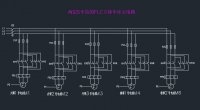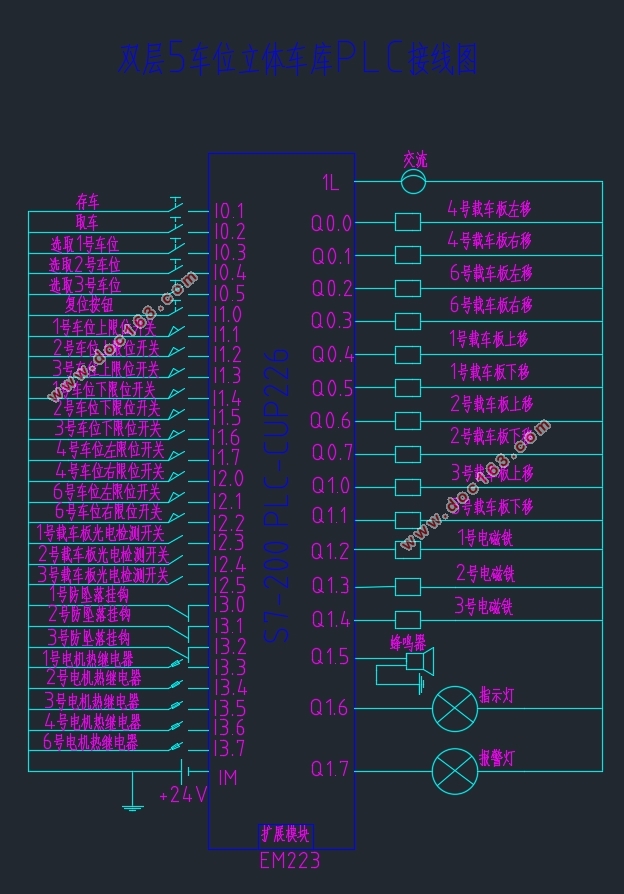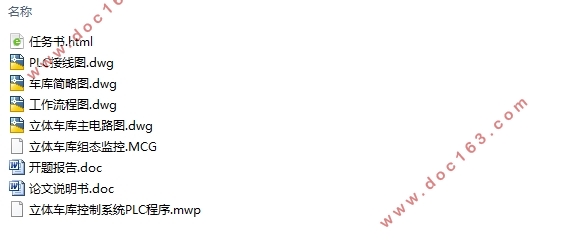基于PLC立体车库控制系统(二层五车位)设计(附PLC程序,接线图,电路图)

基于PLC立体车库控制系统(二层五车位)设计(附PLC程序,接线图,电路图)(任务书,开题报告,论文说明书14000字,CAD图4张,PLC程序)
摘 要
随着我国人民生活水平的不断提高,越来越多的人选择私家车作为自己的出行工具,传统的单层停车库已无法满足人们的停车需求,停车难已成为阻碍城市发展的主要问题之一。因此,设计一种能够停放更多车辆的立体车库对城市的发展显得十分重要。立体车库能够充分利用立体空间,在有限的占地面上实现最大化存取车辆。随着我国科技水平的不断提高,近些年,自动化相关技术得到了迅猛发展,PLC技术在工控领域中的应用越来越广泛。
本文设计的立体车库类型为升降横移式,本车库共有两层且可以提供五个车位,文中主要介绍了该型立体车库的工作原理以及PLC在该案例中的相关应用。此外,本文还介绍MCGS组态软件的相关运用。最后,本文给出了双层五车位立体车库案例的具体实现方案。
关键词:立体车库 可编程逻辑控制器 MCGS 升降横移式
The design of stereo garage control system based on PLC
Abstract
With the continuous improvement of people's living standard in our country, more and more people choose cars as their travel tools, the traditional single parking garage already cannot satisfy the people's parking needs. Parking problem has become one of the major problems hindering the development of the city. Therefore, it is very important for the development of the city to design a stereo garage to park more vehicles. Stereo garage can make full use of the stereo space, maximize parked vehicles in the limited covering space. With the constant improvement of science and technology in China, the automation technology got rapid development. In recent years, the PLC technology is more and more widely used in the field of industrial control.
In this design, the type of three-dimensional garage is Lifting and transferring parking,This garage consists two layers and can provide 5 Parking spaces. This design mainly introduces the principle of this garage and the use of PLC in the case. In addition, this article also introduces the related use of MCGS software. Finally, this article presents a scheme of double five stereo parking garage.
Key Words:Stereo garage; PLC; MCGS; Lifting and transferring
[版权所有:http://DOC163.com]




[来源:http://www.doc163.com]
目 录
摘 要 I
Abstract II
第一章 绪论 1
1.1 本课题的背景 1
1.2 本课题的目的及其意义 1
1.3 本课题的主要内容 1
第二章 立体车库的简介 3
2.1 立体车库的定义 3
2.2 立体车库的分类及其特点 3
2.2.1 升降横移类 3
2.2.2 巷道堆垛类 3
2.2.3 垂直提升类 4
2.2.4 垂直循环类 4
2.2.5 多层循环类 4
2.2.6 简易升降类 5
第三章 立体车库控制系统分析 6
3.1 控制器的选择 6
3.1.1 可编程逻辑控制器的构成 6
3.1.2 PLC的工作原理 7
3.1.3可编程逻辑控制器的特点 7
3.1.4 PLC的主要应用 8
3.2 组态软件的选择 10
[资料来源:http://doc163.com]
3.2.1 MCGS组态软件简介 10
3.2.2 MCGS组态软件的特点 10
第四章 控制方案设计 12
4.1 控制系统的工作原理 12
4.1.1 立体车库的工作过程 12
4.1.2 立体车库的工作流程图 13
4.1.3 立体车库的主电路 14
4.2 控制系统的硬件设计 15
4.2.1 防坠落装置的选择 15
4.2.2 驱动装置的选择 15
4.2.3 限位装置的选择 16
4.2.4 光电开关的选择 16
4.3 控制系统的软件设计 17
4.3.1 控制系统的PLC程序设计及调试 17
4.3.2 MCGS组态界面的设计 32
第五章 总结与展望 40
5.1 总结 41
5.2 展望 41
参考文献 42
致谢 44
附录 45 [资料来源:http://doc163.com]
上一篇:基于PLC的柔性立体仓库设计
